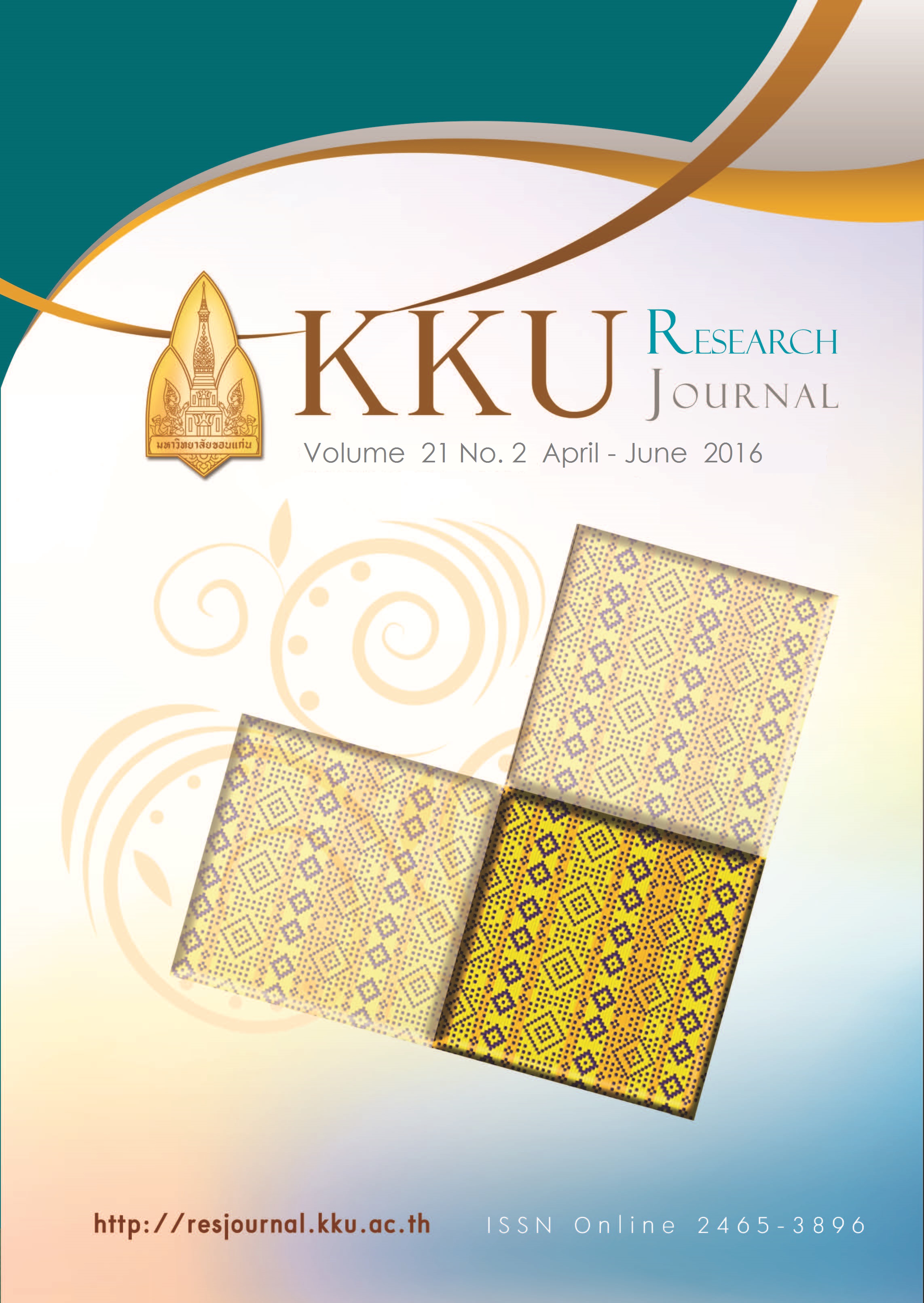Effects of rhizobacteria on seed germination of water spinach (Ipomoea aquatica)
Main Article Content
Abstract
Rhizobacteria are considered as the most useful microorganism based on their properties in nitrogen fixing, phosphate and potassium solubilizing, IAA and other plant hormones which improve the germination of seed. However, seed germination varied depending on stimulator such as bacterial strains, bacterial growing media. This investigation focused on testing the germination of Ipomoea aquatica vegetable by using three rhizobacteria isolates including H1-702, C1-112, P1-5071 and their growing media. Percentage of seed germination, shoot length, root length and number of root hairs of I. aquatica were lowest found in nutrient media treatments without bacteria (50%, 1.67 cm, 1.47 cm, and 1.47, respectively) while the highest numbers were obtained from the treatment of soaked seed with bacterial suspension which gave rise 90%, 4.88 cm, 3.01 cm and 19.26, respectively. Among all treatments, percentage of seed germination was highest (83%) in the single inoculums treatments C1-112 and H1-702. In day 5, the highest root length (2.4 cm) and root hair number (22.05) was showed in H1-702 treatment while C1-112 treatment revealed the highest shoot length (4.52 cm). The combination of two bacterial isolates did not stimulate the germination of I. aquatica, especially, P-H treatment which got the lowest number in all observation data.
Article Details
References
germination stimulants of Strigahermonthica African Journal of Agricultural Research Vol. 2(1), pp 027-032.
[2] Davies, P.J. 1987. The plant hormones: their nature, occurrence, and functions. In: Plant hormones and their role in plant growth and development.MartinusNijhoff Publishes, Dordrecht, pp. 1-11,Springer Netherlands, New York.
[3] Dijk, E., Eck, N. 1995. Ammonium toxicity and nitrate response ofaxenically grown Dactylorhizaincarnate seedling. New Phytot 131, pp 361-367
[4] Hari, M., Perumal K., 2010. Biofertilizer. Shri AMM MurugappaChettiar Research
Centre Taramani. Chiennai- 6000113, 4-5.
[5] Jampeetong, A., Brix, H., Kantawanichkul, S. 2012. Effects of inorganic nitrogen forms on growth, morphology, nitrogen uptake capacity and nutrient allocation of four tropical aquatic macrophytes (Salviniacucullata, Ipomoea aquatica, Cyperusinvolucratus and Vetiveriazizanioides). Aquatic Botany 97,pp 10-16.
[6] Karthikeyan, B., Abdul J.C., Lakshmanan G.M.A., M. Deiveekasundaram, M. 2008. Studies on rhizosphere microbial diversity of some commercially important medicinal plants. Colloids and Surfaces B: Biointerfaces 62, pp 143-145.
[7] Khamwan, K., Akaracharanya, A., Chareonpornwattana, S., Choi, Y.E., Nakamura, T., Yamaguchi, Y., Sano, H., Shinmyo, A. 2003. Genetic transformation of water spinach (Ipomoea aquatica). Plant Biotechnology, 20 (4), pp 335-338.
[8] Mitra, G.C. 1989. Biology, conservation, and culture of orchids, in vitro culture of orchid seeds for obtaining seedlings. East – West Press pvt ltd. pp 401-409.
[9] Monaliza, M.M.A., Newton, P.S., Carolina, E.R.S., Santos, A.D.S.F., Clayton A.S., Mário A., Lira, J. 2013. Effects of biofertilizer with diazotrophic bacteria and mycorrhizal fungi in soil attribute, cowpea nodulation yield and nutrient uptake in field conditions. Scientia Horticulturae 162, pp374-379.
[10] Nantakorn, B., Neung, T., 2010. Effect of plant growth promoting rhizobacteria (PGPR) inoculation on microbial community structure in rhizosphere of forage corn cultivated in Thailand. European Journal of Soil Biology 47, pp
44-54.
[11] Piromyou, P., Bancha, B., Piyada, T., Panlada, T., Nantakorn, B., Neung, T., 2010. Effect of plant growth promoting rhizobacteria (PGPR) inoculation on microbial community structure in rhizosphere of forage corn cultivated in
Thailand. European Journal of Soil Biology 47, pp 44-54.
[12] Roychowdhury, R., Ray, S., Umrao, V. K., and Tah, J. 2012. Comparative study for the effect of gibberellic acid, kinetin and indole 3-acetic acid on seed germination performance of Dianthus caryophyllus. Journal of advanced laboratory research in biology Vol 3(3),pp 166-170.
[13] Sachev, D.P., Chaudhari, H.G., Kasture, V.M., Dhavale, D.D. and Chopade, B.A. 2009. Isolation and characterization of indole acetic acid (IAA) producing Klebsiella pneumonia strains from rhizophere of wheat (triticumaestivum and their effect on plant growth. Indian Journal of Experimental Biology, 47, pp 993-1000.
[14] Shahab, S., Ahmed, N. and Khan, N.S. 2009. Indole acetic acid production and enhanced plant growth promotion by indigenous PSBs. African Journal of Agricultural Research 4 (11), pp 1312-1316.
[15] Somkiat Kham-iam, S., Kanalerk, C., Soonthornpat, S., Boonkerd, N., Santadwoo, M. 2005. Compost. National Bureau of Agricultural Commodity and Food Standards Ministry of Agriculture and Cooperatives. ICS 65.080 ISBN 947-403-339.
[16] Sritongon, K. 2015. Screening of plant growth promoting rhizobacteria from rhizosphere for improving growth of Jerusalem artichoke (Helianthus tuberosus L.). A Thesis, Degree of Master of Science in Microbiology,
Khon Kaen Univeristy, Thailand: 105 p
[17] Vrbničanin, S., Božić. D., Sarić, M., DanijelaPavlović, D. and Raičević, V. 2011. Effect of Plant Growth Promoting Rhizobacteria on Ambrosia artemisiifolia L. Seed Germination. Pestic. Phytomed. (Belgrade), 26(2), pp 141-146.[18] Wargovich, M.J. 2000. Anticancer properties of fruits and vegetables. Hort Science, 35 (4), pp 573-575.
[19] Zhang, Q.,Achal, V., Xu, Y., Xiang, W. N. 2014. Aquaculture wastewater quality improvement by water
spinach (Ipomoea aquatica Forsskal) floating bed and ecological
benefitassessment in ecological agriculture district. Aquacultural Engineering 60: pp 48-55


